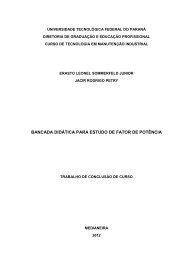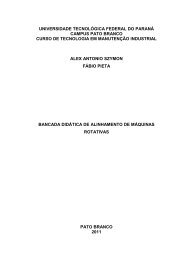utilização de farinha extraída de resíduos de uva na ... - UTFPR
utilização de farinha extraída de resíduos de uva na ... - UTFPR
utilização de farinha extraída de resíduos de uva na ... - UTFPR
Create successful ePaper yourself
Turn your PDF publications into a flip-book with our unique Google optimized e-Paper software.
ABSTRACT<br />
PERIN, E. C.; SCHOTT, I. B. Use flour extracted from grape residue in the preparation<br />
of biscuit type cookie. 2011, 62f. [Trabalho <strong>de</strong> Conclusão <strong>de</strong> Curso] Coor<strong>de</strong><strong>na</strong>ção do Curso<br />
Superior <strong>de</strong> Tecnologia em Alimentos, Universida<strong>de</strong> Tecnológica Fe<strong>de</strong>ral do Paraná,<br />
Francisco Beltrão, 2011.<br />
The industrialization of grape is wi<strong>de</strong>ly held, for the processing of different products,<br />
including wine, juice, jam, marmala<strong>de</strong> and raisins, along with their application in other areas,<br />
such as the manufacture of beauty products. However in its processing wastes are generated,<br />
which mostly end up being discar<strong>de</strong>d without giving it a suitable target, wasting what could<br />
have one use and then be used to make products with ad<strong>de</strong>d value. Solid waste from<br />
industrialized grape that may have economic interests are the pulp, seeds, stems, sludge,<br />
see<strong>de</strong>d, brochures, and fun. Many of these wastes have a variety of biologically active species<br />
and are rich in phenolic compounds. In this context, evaluating the importâmcia these aspects<br />
mentioned above, this study aimed to prepare a meal from bagasse generated in the<br />
production of grape juice, to <strong>de</strong>velop a meal of biscuits and assess the bioactive compounds<br />
present in the residue, flour and biscuits produced. The study was conducted by means of<br />
physical-chemical properties of flour, which were pH, acidity, moisture and ash to<br />
characterize them. From the formulations are prepared flour cookies with substitutions of 5,<br />
10 and 15% of wheat flour for cake flour. Sensory a<strong>na</strong>lysis was subsequently performed with<br />
80 judges being applied a test of consumer acceptance and intent in or<strong>de</strong>r to <strong>de</strong>termine the<br />
most acceptable sample for later realization of bioactive compounds. The cookie with the<br />
addition of 10% flour grape marc was what had the most accepted being evaluated total<br />
polyphenols, total anthocyanins and antioxidant capacity of the same. The flour was within<br />
the limits stipulated by the legislation and the physico-chemical variables a<strong>na</strong>lyzed.<br />
Regarding the a<strong>na</strong>lysis of bioactive compounds bagasse, flour and cookie showed the<br />
compounds studied, being found in greater quantities in the bagasse. This study allowed the<br />
<strong>de</strong>velopment of grape pomace flour and cookie, and characterization of bioactive compounds<br />
from grape pomace generated in the production of grape juice and byproducts, e<strong>na</strong>bling the<br />
correct disposal of waste, its use , as well as providing the company products with potentially<br />
beneficial to health.<br />
Key-words: Grape, Residue, Flour, Cookies, Bioactive compounds.









